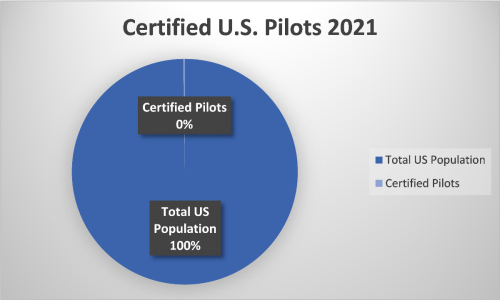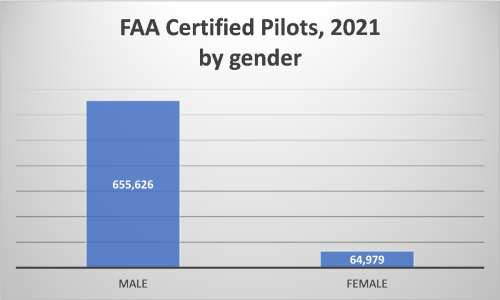Chronic Reliance of General Aviation Airports on Corporate Welfare
Most Americans who fly on commercial airlines are aware that the federal government, through the Federal Aviation Administration (FAA), is involved in regulating the airspace, presumably ensuring that the industry serves the needs of the public. In the process, a great deal of taxpayers' money makes its way to aviation interests.
What many Americans do not realize is that commercial airports comprise an extremely small percentage of the total number of airports in the nation, and the taxes and passenger fees they pay subsidize a vast network of General Aviation (GA) airports that cater to a tiny minority of private users, who exploit this largesse for personal gain, while inflicting harm on surrounding communities.
According to the Bureau of Transportation Statistics, in 2020 there were a total of 19,919 airports in the U.S. (a 283 airport increase compared to 2019). Of that number, 519 were listed as commercial and 19,395 were categorized as general aviation. The pie chart and bar graph below illustrate this data.

Commercial airports provide scheduled airline passenger and cargo services. Many also service piston-engine aircraft. General aviation airports by contrast serve civil, non-commercial aviation flights including private pilots, flight training schools, for-profit aviation businesses, jet owners, air taxis and charter companies.
Bear in mind, when viewing the above graphics, that taxpayers and the passengers departing and arriving from commercial airports subsidize General Aviation (GA) airports. According to the FAA, the Airport Improvement Program (AIP) is derived from aviation user fees levied on airline passengers, air freight and aviation fuel. AIP grants cover 75 percent of eligible costs for commercial airports and 90 to 95 percent of costs for general aviation airports, including infrastructure projects such as runways, taxiways, airport signage, airport lighting, airport markings and land acquisition.
Airports and airport businesses are also recipients of public money through other government sources including but not limited to the Airport Coronavirus Response Grant Program, Airport Rescue Grants, the Paycheck Protection Program (PPP), and the 2021 Infrastructure Bill.
Who Benefits from General Aviation Airports?
Since the vast majority of airports in this country, a whopping ninety-seven percent, are categorized as general aviation, it is instructive to consider exactly who benefits.
FAA Civil Airmen Statistics reveal that as of 2021, there were 720,605 active pilots certified to fly aircraft out of GA airports, less than one-quarter of one-percent of the total U.S. population (331,893,745), a number so small that it appears as 0% on a pie chart. Yet ninety-seven percent of U.S. airports serve this barely detectable minority.

This bar graph below shows a breakdown of the total certified pilot population by category as provided in the 2021 FAA Civil Airmen Statistics.

The numbers in the student pilot column may be inflated as per the FAA, "Starting with April 2016, there is no expiration date on the new student pilot certificates, which generates a cumulative increase in the numbers." The Airmen's statistics also state that without including the student pilot category, the number of certified pilots for 2021 is 470,408, approximately one-seventh of one percent of the U.S. population.
FAA Airmen Statistics for 2021 also reveal that the majority of pilots using these airports, 91 percent, are men.

What these graphics make abundantly clear is that federal aviation policies, the FAA, and GA airports have a long history of perpetuating the institutionalized, white privilege, patriarchal values that continue to have such a devastating impact on the health and well-being of the entire planet and that further contribute to the ever-growing disparity between a wealthy few and everyone else.
Primary Users of U.S. General Aviation Airports
Piston-Engine Aircraft Pilots – Mostly Private Pilots and Flight Students
Investopedia describes owning a small plane "say a Cessna", as a status symbol. "After all, only the most rich and elite own their own, personal airplanes, so if you can count yourself among them, you're one step ahead of the game."
These aircraft owners and other private pilots are some of the primary users of GA airports, as are student pilots and flight training schools, all of whom predominantly fly piston-engine aircraft that still rely on leaded aviation gasoline. GA pilots are responsible for 70 percent of all airborne lead pollution nationwide, and continue to pump more than 468 tons of lead into the environment every single year. In addition, this sector is responsible for generating relentless noise as well as a host of other toxic pollutants.
Private, Corporate, Charter and Business Jets
Owners of recreational, corporate, charter and business jets are also beneficiaries of subsidized GA airports. Though jets don't use leaded gasoline, they are major polluters who benefit from generous public subsidies. Many ultra-rich jet owners place insatiable demands on legislators and local communities for longer and bigger publicly funded runways. According to Investopedia "A private jet can cost anywhere from $2 million to over $100 million..." Less expensive alternatives "include private jet charter services, partial jet ownership, and membership in a private jet club...Chartered flight rates range from the low thousands to more than $10,000 per flight hour." In addition, the cost of insurance, storage, crew salaries, maintenance and repair must be factored in. Obviously, this mode of air travel is way beyond the reach of the majority of Americans, most of whom will never fly out of a general aviation airport.
Elected Officials
Many elected officials have positioned themselves to profit handsomely from this arrangement via contributions lavished upon them by aviation industry lobbyists and political action committees that have been wildly successful in buying their votes, thus ensuring a self-perpetuating system by which public money is continuously cycled between lawmakers and wealthy aviation cronies.
Lost in the shuffle are the American people, the more than 99.75 percent, who receive virtually no representation whatsoever. Many have experienced a significant loss of livability as well as the right to the enjoyment of their property due to the excessive noise, lead emissions, CO2, and other toxic pollutants generated by the aviation industry. Some have literally been driven from their homes and forced to relocate in an effort to safeguard their physical and mental health from this onslaught. Others are left to deal with lifelong medical issues caused by aviation activity.
General Aviation Caucus
A prime example of the sell-out of our local communities and the environment to this miniscule minority is evidenced by the Congressional GA Caucus.
According to a Pilots of America report, the formation of the Congressional General Aviation Caucus was initiated in 2009 by the Airport Owners and Pilots Association (AOPA), an organization that advocates and lobbies on behalf of its 400,000 members, many of whom have the financial wherewithal to own, lease and rent private aircraft. Alarmed at the possibility that the wealthy elite in this county might have to pay for their own extravagant life style choices, AOPA launched a multimillion-dollar lobbying campaign after then-President Barack Obama proposed replacing aviation excise taxes with user fees, "a change that could cost aircraft owners an estimated $9 billion a year."
According to Open Secrets, in 2009 and 2010, the AOPA's lobbying expenditures totaled $3,020,000 and $2,920,000 respectively, which was apparently more than enough to buy the influence of federal legislators who proved to be all too willing to force the American public to subsidize airports on behalf of affluent aircraft owners, aviation businesses and pilots. The AOPA has continued to spend millions on lobbying efforts in the ensuing years.
As noted by Open Secrets, "While an individual's vote carries an expectation that the candidate will look out for constituents' interests if elected, a campaign contribution may carry an expectation that the money will be repaid in the form of favorable legislation, less stringent regulations, political appointments, government contracts or tax credits, to name a few forms of payback." Such is the case with the Congressional General Aviation Caucus, which according to the National Business Aviation Association (NBAA) now has more than 200 members. To view a list of Congressional Senators and Representative by state who serve on this caucus, click here.
Members of the caucus are often generously rewarded for their loyalty via financial contributions from aviation interests. A prime example is GA Caucus member Oregon Rep. Peter DeFazio, who is also the current chair of the House Transportation and Infrastructure Committee. He has received a total of $966,311 from the Air Transport Industry over the course of his career. Not surprisingly, the AOPA is listed as one of his top contributors. Needless to say, he is not a member of the Quiet Skies Caucus nor has he championed the elimination of lead from aviation fuel.
Other members of the GA Caucus are also richly rewarded for their loyalty to the barely detectable but very wealthy less than one-quarter of one percent of the U.S. population that are the primary beneficiaries of the 19,395 general aviation airports in this country. Like Rep. Peter Defazio, Sen. John Boozman, current Co-Chair of the Senate GA Caucus is a frequent recipient of AOPA PAC contributions, as is Rep. Sam Graves, who Co-Chairs the House GA Caucus. For an Open Secrets listing of the Senators and Representatives who receive money from the AOPA each election cycle click here.
Concluding Remarks
The abuse of the public trust and taxpayer dollars to advantage a wealthy few at the expense of the many raises a number of serious concerns.
A glaring question that arises is if GA airports are such an asset to the economy, why are they chronically reliant on corporate welfare handouts, monies that could be far better spent on environmental safeguards, global warming mitigations, EPA noise office funding, environmental justice protections, schools, medical treatment facilities, affordable housing, sustainable high speed rail options and a host of other worthy causes.
Why are GA pilots given a free pass to poison entire communities with toxic lead, intrusive noise, and other pollutants? And why are they allowed to engage in an unrelenting pattern of harassment, intimidation, bullying, abusive assaults and attacks on local residents?
This entire situation represents the complete failure of elected government officials to uphold the basic and fundamental principles of democracy – government of, by and for the people. Instead they have chosen to pander to an elite and extraordinarily rude, inconsiderate, and environmentally irresponsible few.
| © Oregon Aviation Watch | Contact Us |  Jump to Top Jump to Top |
